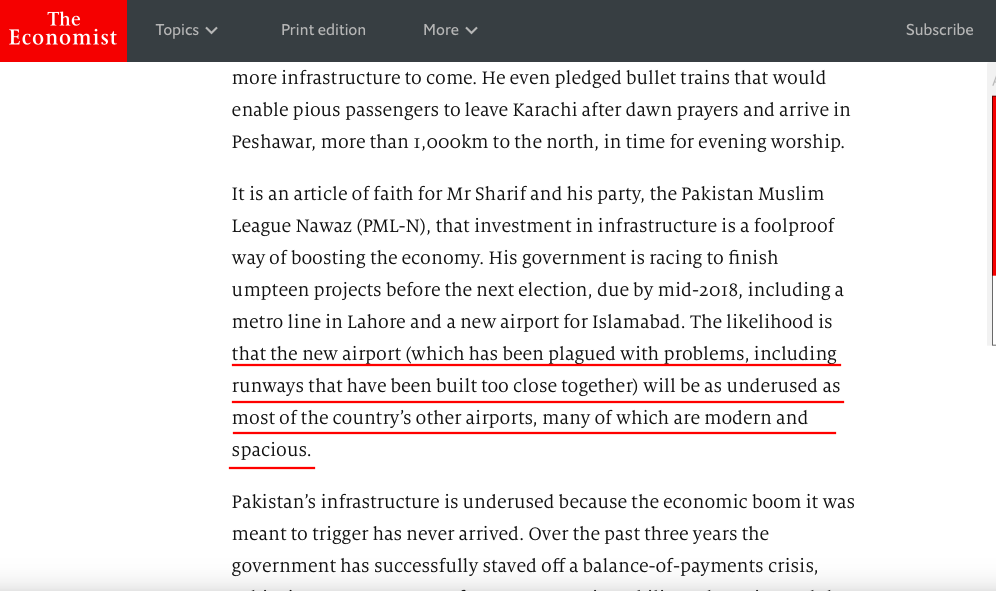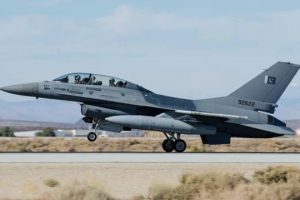World leading publication The Economist recently published a story with their own comment that the new Islamabad Airport’s “runways that have been built too close together”. Now if it was Pakistani media or a click bait hungry local blog we could have ignored it, because we can not expect from them to google their story before they publish to fact check. But this is The Economist and when it got this basic thing wrong and got itself carried away with the gossip and rumour mill we feel there is big problem.
New Islamabad airport has many myths attached to it and from politicians sitting in parliament to journalists all have their own gossips and stories to share that are mostly untrue. But a publication like The economist picked the gossip up and published it without checking the facts. This is not
So lets come to the point because the whole story has too many loop holes that we can not waste our time to answer so lets do it for the runway.

Is it true that Islamabad airport runways are built too close to each other?
What does international standards say?
In the United States, the FAA has published Advisory Circular 150/5300-13A, Airport Design , which includes recommendations for parallel runway separation.
- “For simultaneous landings and takeoffs using VFR, the minimum separation between centerlines of parallel runways is 700 feet (213 m).”
- For simultaneous IFR operations, “Dual simultaneous precision instrument approaches are normally approved on parallel runway centerline separation of 4,300 feet (1311 m). On a case-by-case basis, the FAA will consider proposals utilizing separations down to a minimum of 3,000 feet (914 m) where a 4,300 foot (1311 m) separation is impractical. This reduction of separation requires special high update radar, monitoring equipment, etc.” Note: Simultaneous Offset Instrument Approaches allow as little as 750 ft between runway centerlines.
International regulations do differ. ICAO have their own standards. Here is an example of a document which prescribes airport standards compliant to ICAO Annex 14.
Based on ICAO doc9157 Aerodrome Design Manuel Part1 Runway, the minimum distance between centre lines of 2 parallel( or near-parallel ) runways is
For Visual Meteorological Conditions (VMC) operation:
- 210m for category 3( runway length=1200m-1800m ) and category 4( runway length>1800m )
- 150m for category 2( runway length=800m-1200m )
- 120m for category 1( runway length<800m )
And for Instrument flight Condition (IMC) operation:
- 1035m for independent parallel approaches ( radar separation minima between aircraft and adjacent centre line is not prescribed)
- 915m for independent parallel approaches ( radar separation minima between aircraft and adjacent centre line is prescribed)
- 760m for independent parallel departures or Segregated parallel operations (one exclusive for departure and another for landing)
When two runways are closer than the regulations above, only one can be “operated” at the same time (eg: LGW). Even though only one of the parallel runway would be operated at the same time, the separation of the runway have to follow the “Runway strip rule”, which is
- 75m each side from the centre lines for category 3/4
- 40m each side for category 2
- 30m each side for category 1
- Therefore minimum distance of two parallel runways is the sum of the strips,ie: minimum distance of two parallel 4E/F runways is 75+75=150m from their centre lines.
The above is global standard which represents the minimum requirement of runway , other aviation authorities such as FAA in US may have stricter standard.
So is it true that distance between the runways is such a huge deal? We know for sure that some of the world’s major airport have runways that are just a hundred feet apart. Even in Pakistan Lahore and Karachi airports have the same situation. The issue is that the closer the runways are, the more separation the planes using those runways must have, and the higher the IFR minima.
We asked the Aviation division and CAA about it and here is what they said.
“The second runway in Islamabad is not going to be used for parallel operation simultaneously. It is built so if there is an emergency or the main runway is blocked for whatever reasons the operations at the airport are not affected. Also the distance between both runways is right as per international standards.”
It is important to mention here that in the past a CAA official’s answer to lawmakers was published to portray as if he is saying that it was a technical error. According to our research he was answering a specific question that “if these two runways could be used for simultaneous operations as parallel runways”. To which he rightly answered no and when pressed why he said it was a technical problem at the time of conception. Now right from the beginning the plan has been changed more than once so the original plan as published was not implemented. Then whose fault it is? Or maybe it was always planned as a secondary runway to support the main runway.
Now we come to the second point claimed by The Economist.
“The likelihood is that the new airport will be as underused as most of the country’s other airports, many of which are modern and spacious.”

In Pakistan no government plans for future and it seems that The Economist (because there is no name with the article) has an issue with the planing. So to help the writer understand let us explain few bits. In last 3 years the number of aircrafts owned or operated by Pakistani airlines have doubled in numbers. There is one new domestic airline two in the pipeline and Bhoja and Air Indus planing to make a comeback.
With this challenge the space at airports specially at Islamabad airport is not sufficient to cater for this. With just 3 wide bodies the airport system grinds to a slow pace. That affects the whole operation and makes the experience bad for passengers. To cater to growing demand of travellers it is wise to plan for them in advance. So the author of The Economist is misguided or intentionally trying to misguide its reader on this front. The airport in Lahore is already proving to be not enough for its operations so it is wise to build for future, which is not even ten years old.
If The Economist care to look into this we are more then happy to help but please don’t publish half cooked and ridiculously one sided pieces that contradict your own published stories from the past.

















Add Comment